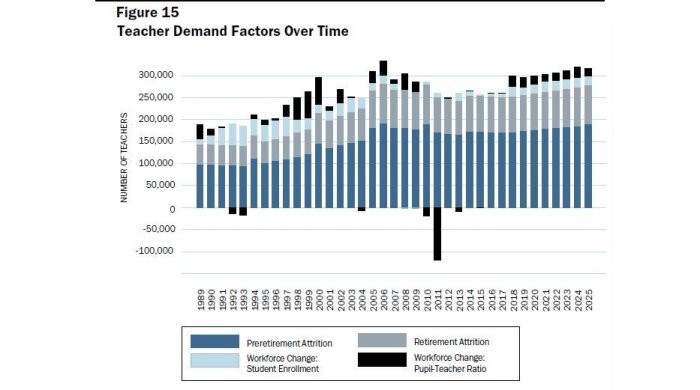
WASHINGTON, Sept. 15 (UPI) — The United States is facing its first major teacher shortage since the 1990s, an intensive study conducted by an education think tank based on reams of federal data and projected trends said Thursday.
The 100-page report by the Learning Policy Institute said a major reason for the shortage is the Great Recession, the period of time a few years ago that saw many U.S. school districts downsize and slash curriculum as an economic measure.
Now that school sizes and classes are returning to normal, the study’s authors say there’s a looming shortfall in the size of the educator workforce.
“Teacher demand increased sharply after the Great Recession,” the institution said. “Projections show a large increase in 2017-18 and a projected plateau bringing annual hires demanded to approximately 300,000 teachers a year.
“Districts are looking to reinstate classes and programs that were cut or reduced during the Great Recession. It would require hiring an additional 145,000 teachers, on top of standard hiring needs, to reduce average pupil-teacher ratios from the current 16-to-1 to pre-recession ratios of 15.3 to 1.”
The report cites a number of reasons for an “atypically low” teacher candidate pool but recommends changes to increase the appeal of becoming a teacher — perhaps most importantly, increasing notoriously low teacher salaries.
“Create incentives that make living as a teacher more affordable, including housing supports, childcare supports, and opportunities to teach or mentor after retirement to more effectively recruit and retain teachers,” one recommendation states.

About 8 percent of the U.S. teaching workforce leaves every year, the report says, and is possibly the biggest factor responsible for the shortage.
“The teaching workforce continues to be a leaky bucket, losing hundreds of thousands of teachers each year — the majority of them before retirement age,” the institute said. “Changing attrition would change the projected shortages more than any other single factor.”
The potential consequences of the shortage are fewer classes offered, larger class sizes and under-prepared educators entering the industry.
The report got the attention of many political leaders and industry experts.
“I understand the teacher shortage issue, but there’s also a major teacher retention issue, especially teachers of color,” Josh Starr, CEO of pro-education group Phi Delta Kappa International, said.
The minority issue was examined by the institute in an accompanying report, “Minority Teacher Recruitment, Employment, and Retention: 1987 to 2013.”
The institute makes several recommendations to counter a substantial teacher shortfall — including increased compensation, improved working conditions and developing a national teacher supply market.
“Although these proposals are associated with costs, it is likely that they would ultimately save far more than they would cost,” the report concludes. “The savings would include the more than $8 billion now wasted annually on replacement costs because of high teacher turnover … not to mention the broader social costs of dropouts, unemployment, and incarceration.
“Preventing and solving teacher shortages so that all children receive competent, continuous instruction in every community every year is, in a 21st century economy, essential for the success of individuals as well as for society as a whole.”





